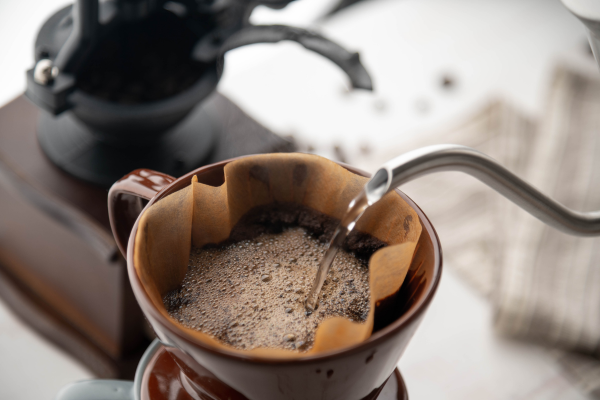A creamy, foamy cappuccino is one of the most beloved coffee drinks around the world. Traditionally made with a shot of espresso and steamed milk topped with thick milk foam, it’s known for its rich texture and balanced flavor. But here’s the good news: you don’t need a fancy espresso machine to enjoy a delicious cappuccino at home.
With a few simple tools and ingredients, you can recreate this café classic in your own kitchen—no barista training required. In this article, you’ll learn exactly how to make cappuccino at home without an espresso machine, using affordable methods and techniques that work.
What Is a Cappuccino?
A cappuccino is a coffee-based drink made with three equal parts:
- Espresso (strong, concentrated coffee)
- Steamed milk (adds body and sweetness)
- Milk foam (adds texture and lightness)
The goal is balance: bold coffee flavor softened by creamy milk, with a thick, velvety layer of foam on top. It’s smaller than a latte, typically served in a 150–180 ml (5–6 oz) cup.
Step 1: Brew Strong Coffee
Since we’re not using an espresso machine, the key is to create a coffee concentrate that mimics espresso’s strength and intensity. Here are three easy alternatives:
1. Moka Pot (Stovetop Espresso Maker)
This is the best espresso alternative. It uses steam pressure to brew strong, bold coffee.
- Use finely ground coffee
- Fill the bottom chamber with water up to the valve
- Fill the filter basket with ground coffee (level it off, but don’t tamp)
- Assemble and heat over medium
- Coffee will collect in the top chamber
2. AeroPress
Use a fine grind and less water for a strong, espresso-style brew.
- Use 15–18g of coffee and 60–70 ml of hot water
- Stir, steep for 30 seconds, and press
3. Strong Drip or French Press Coffee
Brew a smaller amount of water with more grounds (e.g., 2 tablespoons per 100 ml) to make it concentrated enough.
Step 2: Heat and Froth the Milk
Cappuccino foam is a defining feature, and you can achieve it easily at home without a steam wand.
Milk to Use:
Whole milk works best due to its higher fat content, which produces creamy foam. Plant-based alternatives like oat milk or barista-style almond milk can also froth well.
Frothing Methods (No Machine Needed):
- French Press: Heat milk to about 60–65°C (avoid boiling). Pour into a clean French press and pump the plunger vigorously for 20–30 seconds. This creates creamy, dense foam.
- Jar Method: Heat milk and pour into a jar. Close the lid tightly and shake for 30–60 seconds. It’s simple and effective.
- Hand Whisk or Electric Frother: Gently whisk the warm milk until foamy. Handheld milk frothers are cheap and work very well.
For a cappuccino, you want a thick foam layer, so don’t overdo the liquid milk—use roughly equal parts foam and steamed milk.
Step 3: Combine and Serve
Now it’s time to bring it all together:
- Pour your strong coffee into a pre-warmed cappuccino cup. This helps maintain temperature.
- Gently pour the steamed milk over the coffee.
- Use a spoon to scoop the milk foam and place it on top of the drink.
- Optional: Sprinkle with cocoa powder, cinnamon, or even a pinch of nutmeg for flavor and visual appeal.
If you’ve layered it well, you’ll see the coffee at the base, a lighter milk middle, and a fluffy cap of foam on top.
Cappuccino vs. Latte: Know the Difference
Though often confused, cappuccino and latte are not the same. Here’s a quick breakdown:
| Drink | Espresso | Steamed Milk | Milk Foam |
|---|---|---|---|
| Cappuccino | 1 part | 1 part | 1 part |
| Latte | 1 part | 2 parts | Thin layer |
A cappuccino has equal parts coffee, steamed milk, and foam, giving it a stronger flavor and thicker texture. A latte is milkier and smoother with less foam.
Tips for Better Homemade Cappuccinos
- Use fresh coffee beans: Grind them just before brewing for the best flavor.
- Don’t overheat the milk: Keep it between 60–65°C. Boiling it changes the flavor and ruins the foam.
- Use the right cup size: Traditional cappuccinos are served in 5–6 oz cups. Bigger mugs will stretch the ratio and affect flavor balance.
- Practice your foam: Good milk foam is thick but pourable, with tiny bubbles. If your foam is stiff or bubbly, try frothing for less time or using cooler milk.
Make It Your Own
Once you’ve mastered the basic cappuccino, you can customize it to suit your taste:
- Add flavor syrups: Vanilla, hazelnut, caramel
- Try flavored coffee beans for variety
- Use spice blends like pumpkin spice or chai for seasonal twists
- Make it iced: Let your coffee cool, pour over ice, and top with cold milk foam
Homemade cappuccinos can be fun and creative, offering a personalized café experience right in your kitchen.
Final Thoughts: Café-Style Comfort at Home
Making cappuccino at home without an espresso machine is not only possible—it’s satisfying, affordable, and delicious. With a little practice and the right technique, you can recreate that rich, foamy cup without stepping into a coffee shop.
Whether you’re starting your morning, winding down in the afternoon, or treating yourself after dinner, a homemade cappuccino can offer warmth, comfort, and flavor—all in one sip.
So go ahead—brew strong, froth well, and enjoy every layer.

